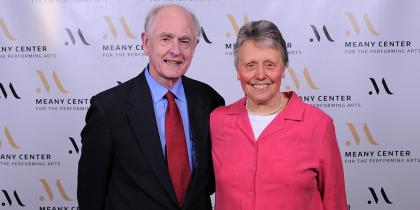You are here
Sylvia and Steve Burges
Not surprisingly for a married couple, Steve and Sylvia Burges have a lot in common: Steve is a civil engineer and Sylvia is an environmental engineer; both love nature—they first met on a low budget ski trip arranged by the International Students Association while they were students at Stanford University in 1969—and both have loved music since childhood.
But those commonalities obscure the wildly different paths these two trod to eventually wind up in the same place.
Born in Illinois, Sylvia says she was exposed to classical music while still in the womb. “It was the soundtrack in our house growing up.” She took piano lessons as a child, but switched to viola in fifth grade. “I wasn’t very good at it,” she says, “but I loved playing in school orchestra—I loved being part of the group.”
For his part, Steve, born in Newcastle, Australia, does not read music, never played an instrument and wasn’t introduced to classical music until high school. “I grew up in a working class steel town,” Steve says. “Of the 170 students in my selective high school graduating class of 1961, 35 went on to University or became lawyers or accountants.” For the first three years of high school, one hour a week was set aside for music appreciation, during which time Steve was introduced to a range of very good music.
His school exposure was augmented by the Australian Broadcasting Commission. “My father used to turn it on during breakfast to hear the national and international news,” Steve recalls. “And they played classical music before and in the break between the two main newscasts.”
Steve’s entry into engineering came a year after enrolling as a metallurgy student at the then Newcastle University College. He followed the advice of a wise engineering faculty member and switched to a five-year double degree (physics and mathematics; and civil engineering). During his last year as an undergraduate, he consulted academic staff members at The University of Newcastle and The University of New South Wales about continuing his studies. As a result of those discussions and their support, he applied to the graduate program in hydrology and engineering economic planning at Stanford in 1967, earning his MS and Ph.D.
Sylvia arrived at Stanford in autumn 1969, having completed a BA in biology at Earlham College in Richmond, Indiana and enrolled in the pharmacology program. Her plans changed, however, when she and Steve married and he became a faculty member in the UW School of Engineering in autumn 1970. She dropped out of pharmacology and later enrolled at the UW, eventually receiving two masters degrees, one in educational psychology, and the other in civil engineering. For many years she worked for the U.S. Environmental Protection Agency as an environmental engineer, enforcing hazardous waste regulations before retiring in 2010.
Like so many with a passion for science, technology, engineering and math, Steve and Sylvia have an equal love for the arts, especially music. And they see it as an integral part of STEM education. “If I had my druthers,” Steve says, “Engineers should have a deep liberal arts education before they go to engineering school—they need to have a broader understanding of the world, and develop “soft skills.” As a professor at the UW, Steve encouraged his students to choose liberal arts and humanities courses carefully for part of their degree requirements. “Young people need to be exposed to the arts at an early age,” he says. “They’re like seed corn for the next generation of arts lovers.”
As ardent supporters of the arts, Sylvia and Steve put their money where their hearts are.
In August, 2019, the couple created the Sylvia and Steve Burges Meany Center for the Performing Arts Endowment, with the purpose of providing “support for the greatest needs benefiting” Meany Center. “We wanted the most flexible way to give Michelle access to what she needs,” Steve says.
While they have been generous supporters for many years through annual giving, creating an Endowment was a signal commitment to Meany Center. Steve points out that the endowment for the Lucasian Chair of Mathematics at Cambridge University was established in 1663—Isaac Newton was its second holder (1669 – 1701); Stephen Hawking one of its most recent 1979 – 2008).
“Endowments outlast the giver,” Steve says. “They can continue supporting important things for a long, long time.”


